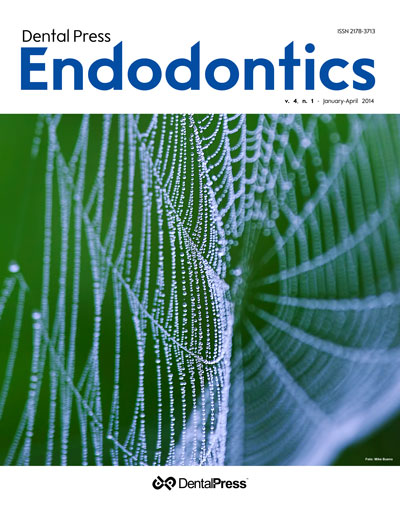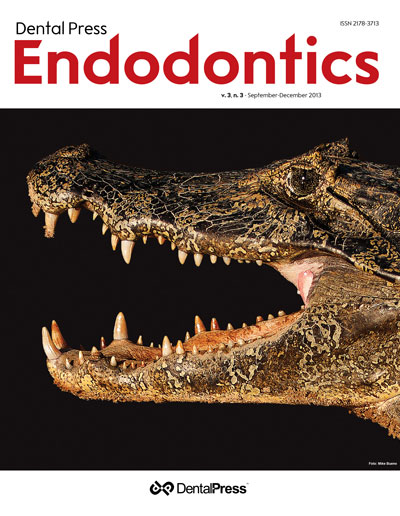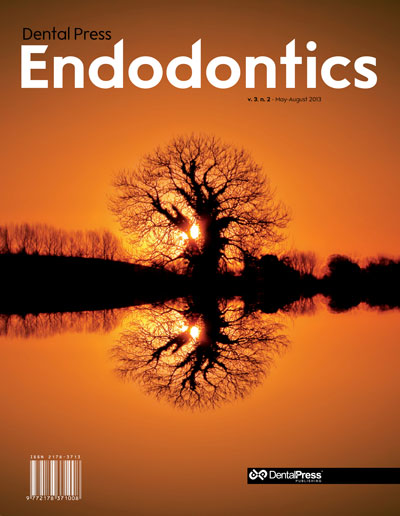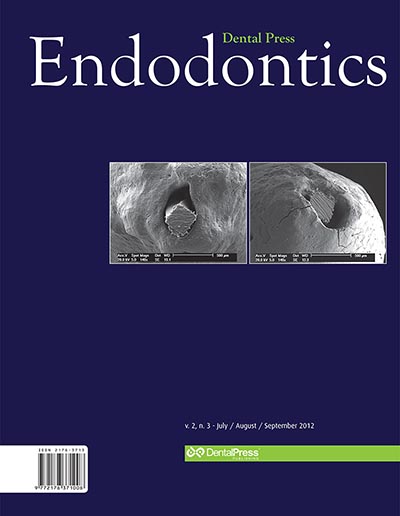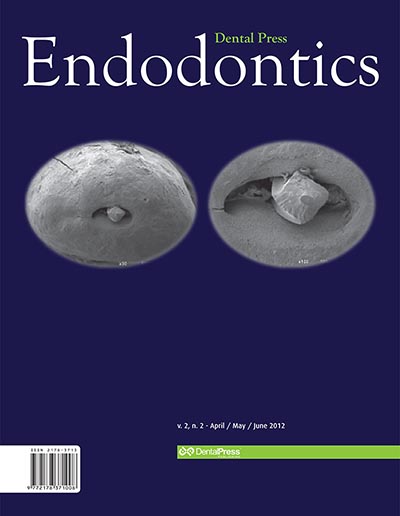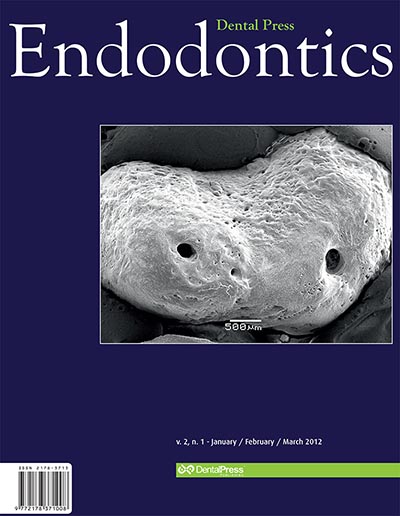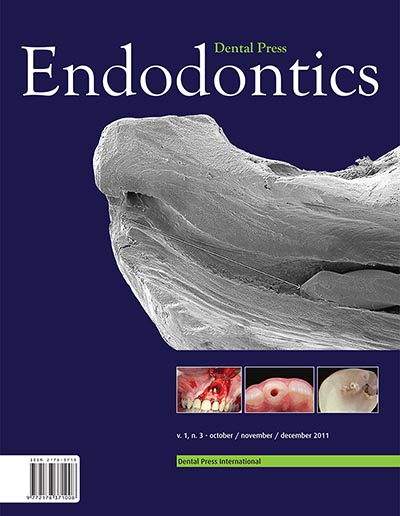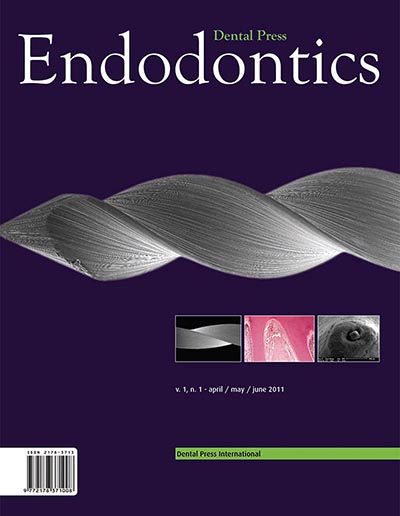v. 02, no. 2
Dental Press Endodontics – ISSN 2178-3713
Dental Press Endod.
v. 02, no. 2
April / May / June
2012
Editorial
Care in the development of a scientific text
3 3
Endodontics journals, in every continent, have received an extraordinary amount of research developed by Brazilians. This international visibility and credibility have often been highlighted, as in a recent editorial published in Dental Traumatology (Impressive research development in dental traumatology from Brazil. Dent Traumatol. Aug 2012, 28[4]:255), by its editor-in-chief, Prof. Dr. Lars Andersson. Such an important comment like this reinforces the need for, each time more, enhancing and improving studies developed here.
The search for new therapeutic strategies able to promote diagnosis and treatment alternatives justifies this researches. Starting from a well elaborated project, a clear and relevant hypothesis, a pilot study able to minimize future problems and that indicates the validity and vulnerabilities of the study, the experiment is developed. After obtaining the results, the transcription phase is set, in a way it is well understood, with adequate and legible scientific and literary structure.
Among cares deserving to be remembered, there are: A title describing directly the study content; an introduction covering important information about the topic and possible innovations; a clear hypothesis that evidences a good problem to be solved; a methodology described in details, so that it can be reproduced; a data analysis with appropriate statistical treatment; a logical, organized and informative presentation of the results, avoiding duplication of pictures, graphs and tables; a discussion of methods and results with rich and precise correlations; a clear conclusion seeking to answer the problem formulated. References and scientific text should be strictly in accordance with the standards of the journal. Once the text is ready, it must be read, reread and corrected, as for the scientific aspects and grammar, prior to submission.
An article with good readership scores, besides being methodologically well-structured should bring contributions to the health process.
Endo in Endo
Bone reaction capability and the names of inflammatory bone disorders in endodontic clinical practice
Osteitis. Osteomyelitis. Periostitis. Osteonecrosis. Periapical diseases.
12 19
Reactional inflammatory bone diseases are common in the jaws and are associated with periapical lesions. A chronic dentoalveolar abscess represents a chronic purulent osteitis, just like periapical granuloma is a chronic granulomatous osteitis. Imagiologically, chronic inflammatory periapical injuries are osteitis which manifest themselves either as bone rarefactions, either as sclerotic areas. The terms “rarefying diffuse lesion” or “sclerosing at the periapex” are used in reports to identify chronic inflammatory periapical lesions that represent true reactive inflammatory bone diseases with specific names by the direct relationship with the teeth as dentoalveolar abscess and periapical granulomas. When teeth are extracted they can leave imagiologically detected structural changes, such as bone sclerosis and rarefactions, without the possibility of establishing a cause and effect relationship, making it hard to provide a secure diagnosis. In planning, a previous diagnosis of bone status implies recognizing injuries and pathological situations. The standardization of nomenclature and concepts can facilitate communication and the establishment of uniform protocols and behaviors.
Original articles
Effects of modified Portland cement and MTA on fibroblast viability and cytokine production
MTA. Cytotoxicity. Dental materials.
20 24
Assessment of success rate of endodontic treatment performed by Brazilian undergraduate students
Endodontics. Treatment failure. Dentistry students.
25 29
Objective: The aim of this paper was to evaluate the success rate of endodontic treatments performed by undergraduate students at São Paulo State University (Brazil).
Methods: A random sample of 94 records from 85 patients who received endodontic treatment was analyzed. All evaluated cases undergone endodontic treatment using the same standardized irrigation solutions and intracanal medication. The criteria used to characterize the clinical successful were: no pain, swelling or fistula and complete or partial regression of apical injury, radiographically observed. Kappa’s test was used to verify the statistic correlation between treatment, clinical and radiographic success.
Results: According to clinical and radiographic evaluation, the success rates were 89.36% and 88.29%, respectively. The statistical analysis indicated that the success of endodontic treatment occurred in 79 (84.04%) of 94 cases (p=0.14).
Conclusion: The treatment of teeth with pulp necrosis performed by Brazilian undergraduate students showed, clinically and radiographically, a high level of success.
Assessment of coronary microleakage marker capacity of three dyes
Dyes. Microleakage.
30 36
Objective: The aim of this study was to assess the marker capacity of 2% methylene blue, 2% Rhodamine B and 5% nickel sulfate.
Methods: After biomechanical canal preparation in 84 single-root pre-molar teeth extracted from human beings, the access cavities were sealed with Coltosol® and the specimens were made impermeable, except for 1 mm adjacent to the temporary sealing. The samples were immersed in the staining solutions and kept in an oven at 37 ºC for 3 and 7 days, and were submitted to thermal cycling. During this period, 300 cycles (5 ºC and 55 °C) of 30 seconds each were performed in a specific appliance with a digital programmer for temperature, time and number of cycles. Longitudinal sections of the specimens were obtained and observed under stereomicroscopic lens.
Results: The statistical results by the Analysis of Variance showed a significant difference (p<0.05) among the groups and between the two time intervals assessed.
Conclusion: There was greater leakage in the 7 day interval in all groups, and the Rhodamine B dye exhibited the higher mean leakage depth values in the two time intervals, followed by methylene blue and nickel sulfate.
Marginal leakage evaluation of three endodontic sealers according to the moment of post preparation
Marginal microleakage. Post preparation.
37 41
Objectives: The purpose of this in vitro study was to evaluate the coronal marginal leakage after post space preparation in teeth filled with three different sealers, according to the period between the root canal filling and preparation of post space.
Methods: Ninety human teeth recently extracted were cleaned and shaped and then filled with Sealapex, Endométhazone or TopSeal. Gates Glidden drills were used for immediate post space preparation of 10 teeth with each sealer until 5 mm of filling were left. Sixty filled roots were incubated at 37 oC in wet environment during 30 and 60 days to have, then, the post space prepared as previously. The external surface of each root was covered with Araldite™. The specimens were immersed in 2% methylene blue dyer under vacuum for 24h; so they could be analyzed. The infiltration was measured by the Sigma Scan (Jandel Scientific) software from the upper part of the obturation to the most apical point reached by the dyer.
Results: Sealapex and TopSeal showed smaller infiltration after post space preparation than Endométhazone; Immediate post space preparation showed smaller infiltration than post space preparation after 30 and 60 days of the root canal filling.
Evaluation of Cell Pack paper points: A microbiological study
Endodontics. Dental sealers. Sterilization.
42 46
Introduction: The presence of humidity inside the root canal system after instrumentation and removal of the septic content can influence the apex sealing and, consequently, the success of the endodontic treatment.
Objective: To evaluate the efficacy of the sterilization method used in these cell-packed paper points; to evaluate whether paper points were contaminated after opening, to evaluate the effectiveness of the autoclave to sterilize the contaminated paper points in their cell packs, and to evaluate whether the calibration of these paper points can contaminate them.
Methods: Dentsply, EndoPoints, Precise, Protaper, SybronEndo, VDW and Tanari cell-packed paper points were used. Evaluations were made according to propositions. In all steps, the paper points were placed onto brain heart infusion broth and incubated at 37º C in a CO2 atmosphere for 7 days. The BHI broth was checked daily for appearance of turbidity.
Results: No paper point removed directly from the cell pack presented contamination; however, contamination was observed when the cell packs were violated; after sterilization, the contaminated paper points were decontaminated; and finally, no contamination was found in paper points seized with sterilized tweezers and placed on a sterilized millimeter ruler.
Conclusion: The cell-packed paper points are sterilized and when violated during handling, autoclaving is necessary and effective.
Subcutaneous tissue reaction to modified Portland cement (CPM)
Biocompatibility. Connective tissue. Mineral trioxide aggregate.
47 52
Introduction: The aim of this study was to evaluate the rat subcutaneous tissue response to implanted polyethylene tubes filled with Modified Portland Cement (CPM®) (Egeo S.R.L., Buenos Aires, Argentina) compared with Angelus MTA® (Angelus, Londrina, Brazil).
Methods: These materials were placed in polyethylene tubes and implanted into dorsal connective tissue of Wistar rats for 7, 15, 30, 60, and 90 days. The specimens were prepared and stained with hematoxylin and eosin or Von Kossa or not stained for polarized light. Qualitative and quantitative evaluations of the reaction were performed.
Results: Both materials caused moderate reactions at 7 days that decreased with time. Angelus MTA® caused mild reactions at 15 days that decreased with time. The response was similar to the control on 30, 60 and 90 days with CPM® and Angelus MTA®. Mineralization and birefringent to the polarized light granulations were observed with both materials.
Conclusions: It was possible to conclude that CPM® and Angelus MTA® were biocompatible in the rat model, and that they stimulated mineralization.
Antibacterial capacity of different intracanal medications on Enterococcus faecalis
Calcium hydroxide. Chlorhexidine. Enterococcus faecalis. Intracanal dressing. Propolis.
53 58
Objective: To evaluate the antimicrobial activity of 2% chlorhexidine gel, copaiba oil, propolis extract and calcium hydroxide associated to propylene glycol on Enterococcus faecalis .
Methods: Fifty single-rooted human teeth were prepared until K-file #50 and distributed into groups according to the intracanal substances. The positive control group was only propylene glycol. Subsequently, 100µL of microorganism broth was inoculated into the roots, except in the negative control group. Then the roots were placed in individual test tubes immersed in BHI and put into incubator at 37° C for 48 hours. After the turbidity of the medium, the roots were irrigated with sodium thiosulfate, filled with one of the test substances and immersed in BHI for 7 days at 37° C. Thereafter, the drugs were removed from the roots with help of K-files and abundant irrigation with sodium thiosulfate. The roots were immersed in BHI for 24 hours. After this, the tubes were analyzed by single trained examiner to the categorization of the culture medium turbidity.
Conclusion: According to this methodology, it was possible to conclude that none substance was effective against Enterocossus faecalis .
Quality of reminiscent root in endodontically treated teeth with intraradicular retainers
Post and core technique. Root canal obturation. Mouth rehabilitation.
59 63
Objective: The objective was to evaluate the quality of root reminiscent of endodontically treated teeth with intraradicular posts.
Methods: This retrospective study assessed the records from every patient treated in the Integrated Clinic of the Dentistry School of Pernambuco University, from 2006 to 2007, which recorded the presence of an intraradicular post, totalizing 78 patients. Two professionals graduated in dentistry evaluated the intraradicular post and root reminiscent data.
Results: For 99 of the evaluated teeth, the post length was lower than 2/3 of the root length in 86,87%, and the post diameter was inadequate in 31.31%, 20.20% and 11.11% in the coronal, middle and apical thirds, respectively. In 51.51% there was a void between the root canal filling and the intraradicular post, and the reminiscent of root canal filling was classified as satisfactory in most cases, mean 6.1 mm. Eight cases showed deviation in the root canal shaping for the post.
Conclusion: The endodontically treated teeth rehabilitated by intraradicular posts did not follow the recommended standards.
Assessment of different clinical methods to identify mesiobuccal root canals of maxillary first molars
Operating microscope. First molar. Cone-beam computed tomography.
64 70
Objective: The purpose of this study was to compare if the quantity of MB2 root canals found in the maxillary first molars increased when visualized at unaided eye and, posteriorly, with an Operating Microscope (OM). The influence of the operator’s experience to localize the additional root canals was also evaluated.
Methods: One hundred extracted maxillary first molars were evaluated by specialists in Endodontics and students of Endodontics specialization. Cone-beam computed tomography (CBCT) was used to confirm the quantity of root canals present in the mesiobuccal root and this evaluation was taken as gold standard for this research. The agreement level between examiners and CBCT images was evaluated by Cohen’s Kappa Coefficient.
Results: There were statically significant differences between specialists (k = 0.234) and students (k = 0.009) when using OM. The best agreement levels were achieved in the student group with Clinical Exam (CE) (k = 0.261) and the specialists with OM (k = 0.234). When the comparison was performed between the dentists there was reasonable agreement between the root canals identification methods: CE (k = 0.275) and OM (k = 0.4245). It was observed in the comparison between the evaluated root canals identification methods that there was moderated significance between specialists (k = 0.558) and students (k = 0.454). Conclusion: The evaluator experience and the OM employment influenced MB2 root canals identification.
Endodontic treatment of three types of dens invaginatus: Report of four cases
Endodontics. Calcium hydroxide. Advanced treatment.
71 79
Dens invaginatus, also known as dens in dens, is a developmental abnormality that presents alterations in the form and volume of teeth, which may affect the crown and root. Its complex anatomy makes endodontic treatment much more difficult to be performed. Four cases of endodontic treatment in teeth with this type of anomaly are presented; one case type I, one case type II and two cases type III, according to Oehlers’ classification. Endodontic treatment only was performed in three of these cases, and endodontic re-treatment and surgical complementation in one case. Long-term proservation of cases 2 and 4 demonstrated periapical repair with apical closure. Case 1 demonstrated total removal of invagination and the formation of an apical mineralized barrier. Proservation for case 3 was not possible because the patient moved away and contact was lost.Although the treatment of teeth with dens invaginatus is complex, it may be successfully performed when supported by correct diagnostic and planning. If necessary it can be complemented with surgical intervention.


